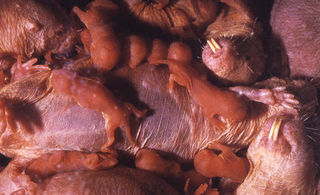
Back in the early 1860s, just a few years after he first published On the Origin of Species, Charles Darwin came up with a hypothesis about Angraecum sesquipedale, otherwise known as the Star-of-Bethlehem orchid, the Christmas orchid, or now, Darwin’s orchid. “Sesquipedale” means foot-and-a-half: it evokes the spectacular nectar spur dangling from it. “What a proboscis the moth that sucks it must have!” was the prediction Darwin made. And after a little scrounging, Alfred Russell Wallace found that moth: a Macrosila species from South America, with a nearly foot-long proboscis.
Predictions in science were becoming common by the mid-19th-century. Dmitri Mendeleev found patterns in his periodic table, and was able to predict the existence of elements so far unknown. And Urbain LeVerrier was able to predict the existence of the planet Neptune, based on orbital irregularities of the planet Uranus. Wallace compared that insight to Darwin’s, in reference to his extraordinary orchid.
Roughly a century later, in lectures he gave in the 1970s, Richard Alexander came up with a prediction of his own. He wondered about what conditions should create a eusocial, or “truly social,” mammal. It would probably inhabit "safe or defensible, long-lasting, initially small, expansible, food-rich nest sites." He thought it might look like a termite.
He was right. When, in the spring of 1976, Alexander gave that lecture in Flagstaff, a biologist in the audience introduced him to the naked mole-rat. Then he put him in touch with the field authority on the subject, Jennifer Jarvis. By the time Alexander met Jarvis in Cape Town, toward the end of 1979, she’d drafted her famous paper for Science, “Eusociality in a mammal.”
Wherever animals get together, they compete. Losers tend to work harder, but raise fewer sons and daughters; winners are often more prolific parents, but work less. That happens all along the “eusociality” continuum. And at the end of that continuum, in the most “eusocial” groups, queens and kings are the only ones who breed: everybody else makes up a sterile caste.
The vast majority of animal species are solitary; only a few live in groups. And as Alexander pointed out in his best-known paper, “The evolution of social behavior,” the reasons are obvious. Animals who live together are often more conspicuous to predators, and they’re more likely to share parasites. They compete for resources, and they compete for mates.
Most animals are social where it’s hard to get away. They occupy habitats that offer good protection from predators, and access to plenty of edible plants or prey. And they cohabit on patches sharply delineated by ecological barriers, where escape in every direction is blocked.
Many eusocial animals live and breed in their food. Aphids live in the galls of trees or shrubs; Australian thrips feed in the leaves of acacia trees; Australian ambrosia beetles bore galleries into Eucalyptus wood; Caribbean snapping shrimp scavenge in the currents of coral reefs; naked mole-rats chew into enormous tubers in the East African underground; termites devour rotting logs. Other eusocial animals store the food they need. Ant species harvest pulp and nectar from flowering plant gardens; honeybees live on the honey they produce in their hives. And in the river valleys from Mesopotamia to China where civilizations began, we stored food too.
Alexander started out as a cricket taxonomist. That got him into the National Academy of Sciences, in his early 40s. But Dick became a great teacher. Over his long and distinguished career he taught: Steve Emlen (a pioneer in the study of animal behavior, and the first TA in Dick’s course on that subject), Mary Jane West Eberhard (the world authority on phenotypic plasticity, and another National Academy member), Dan Otte (and other accomplished cricket taxonomists), Paul Sherman and Bernie Crespi (eminent animal behaviorists, who study the naked mole-rat), Randy Thornhill (the prominent student of sexual selection), John Hoogland, Rick Howard and Gerry Borgia (with others who study social birds and mammals), Rich Connor, Andy Richards and Rachel Smolker (leaders in the study of dolphin social behavior), Nancy Moran (a National Academy member, and authority on symbioses among species), Joan Strassmann (another National Academy member, who took Dick's course as an undergraduate), Marlene Zuk (also a National Academy member, co-taught by Darwin’s great 20th-century successor, Bill Hamilton), Dave Queller and Steve Frank (theoretical biologists), Stan Braude, Katie Noonan and Eileen Lacey (more students of the naked mole-rat), Bret Weinstein (who infamously taught biology at Evergreen State University), Kyle Summers and David Lahti (organizers of a Festschrift and website on Dick’s behalf), David Marshall and John Cooley (who study cicadas), Paul Turke and Beverly Strassmann (who study human behavior), and Alexander’s old son-in-law, Mark Flinn. That list is incomplete.
Back at the beginning of time, he taught me.
References
Alexander, R. D. 1974. The evolution of social behavior. Annual Review of Ecology and Systematics, 5: 325-383.
Alexander, R. D., K. Noonan and B. Crespi. 1991. The evolution of eusociality. In P. Sherman, J. Jarvis and R. Alexander, The Biology of the Naked Mole-Rat. Princeton: Princeton University Press.
Costa, J. 2017. Darwin’s Backyard: How Small Experiments Led to a Big Theory. New York: Norton.
Summers, K. and B. Crespi. 2013. Human Social Evolution: The Foundational Works of Richard D. Alexander. Oxford: Oxford University Press.


